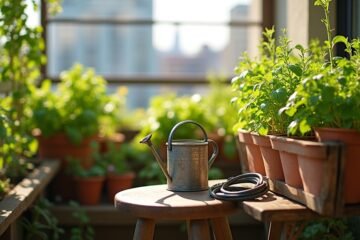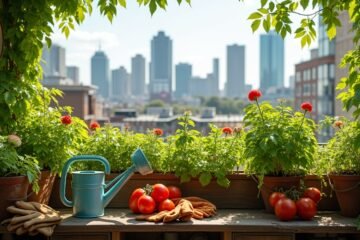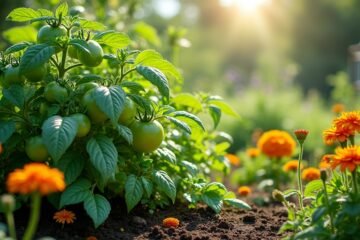You can transform your tiny space into a vibrant garden oasis! By using vertical planters, you’ll free up ground space and create a lush landscape. Think stacked shelves brimming with mint, basil, and thyme! Choose charming containers that not only fit your herbs’ needs but also reflect your style—rustic terracotta or sleek metal, anyone? Plus, incorporating companion plants like tomatoes with basil will boost flavors and deter pesky bugs. Stick around for more creative tips and tricks!
Maximizing Vertical Space for Organic Gardening
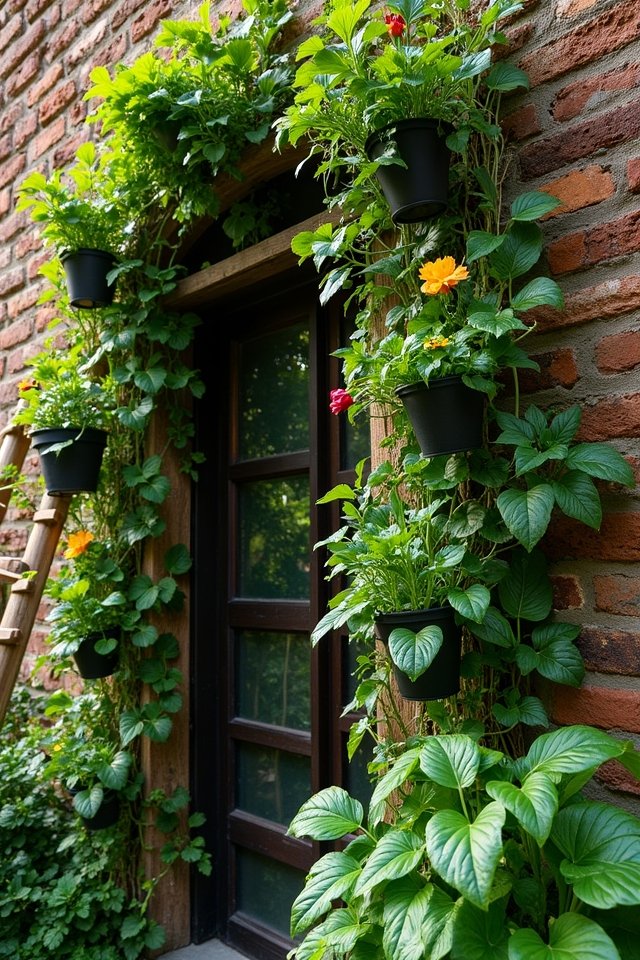
When you’re dealing with a tiny space, it might feel like you’re playing a game of Tetris, trying to fit everything just right! But don’t worry, vertical planters are your secret weapon! Imagine vibrant herbs climbing up your wall, creating a living tapestry of greens and colors. Use wall gardening to transform your flat surfaces into lush vertical landscapes. We’re talking stacked shelves, hanging pots, and even repurposed pallets—fantastic for making the most of your space! Picture basil, mint, and thyme thriving in their new vertical homes, sending aromatic scents wafting through the air. Doesn’t that sound dreamy? With a little creativity, you can squeeze every inch of your space to create a delightful, green sanctuary right at home!
Choosing the Right Containers for Herbs and Vegetables
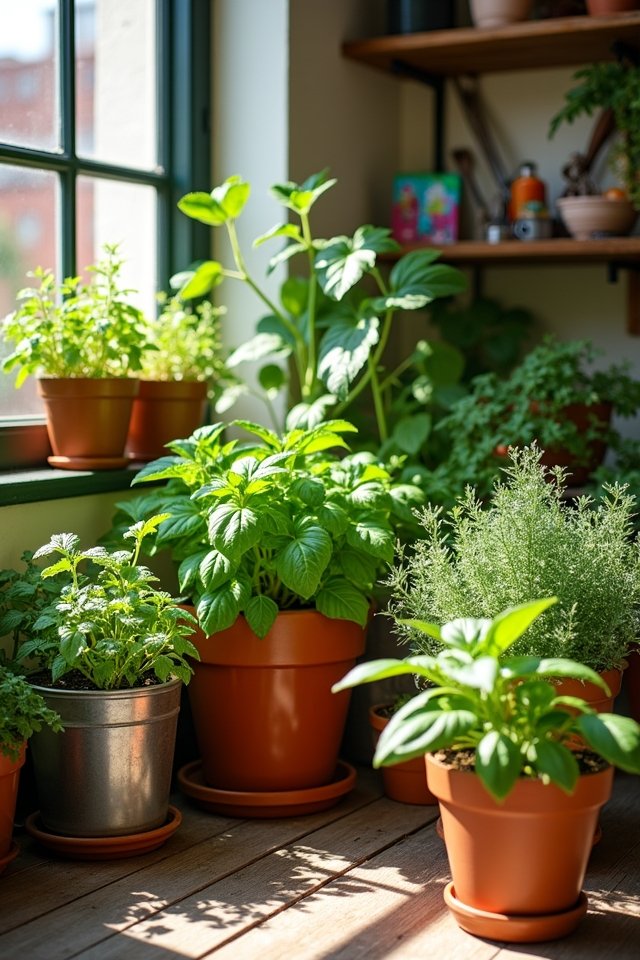
Choosing the right containers for your herbs and vegetables can feel like picking the perfect outfit for a date—fitting style and function is essential! Think about the herb varieties you adore; mint loves space but thrives in a wide pot, while basil prefers something a bit deeper. Go for container materials that match your vibe too—terracotta for a rustic charm, or sleek metal for a modern twist. Don’t forget drainage! Nobody wants soggy roots ruining their plant party. Consider stacking containers for added flair and efficiency, creating a vertical garden that’s both stunning and functional. You’ll have neighbors green with envy at your innovative green thumb! Let’s get those herbs thriving in style!
Companion Planting for Small Gardens
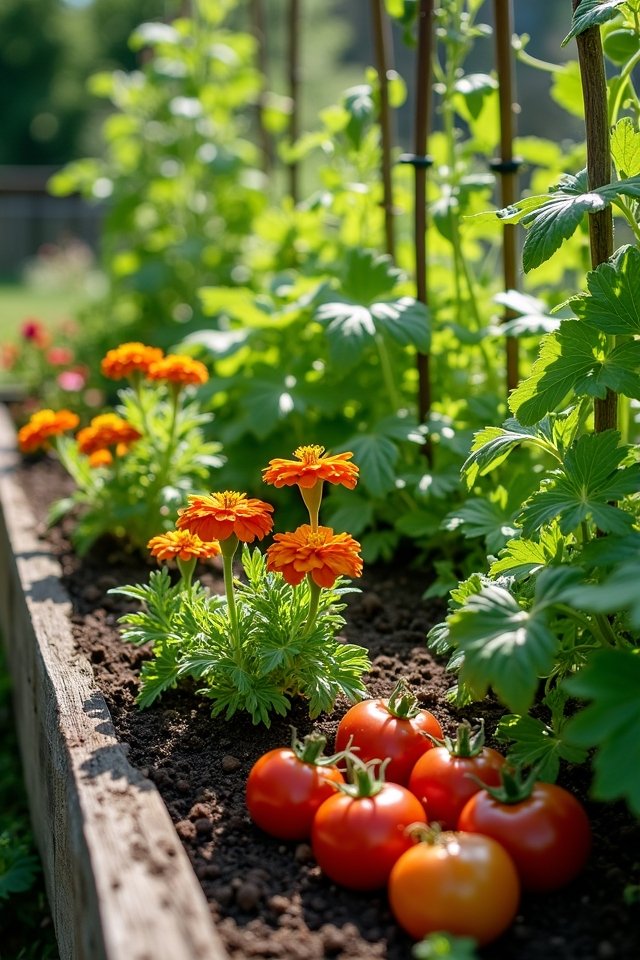
Companion planting isn’t just a clever tactic; it’s like inviting the right friends to your garden party! By pairing companion varieties, you can enhance flavors and improve growth. Imagine tomatoes and basil cozying up together—basil sweetens the deal and wards off pesky bugs. Or how about the lively duo of marigolds and peppers? Marigolds add vibrant garden aesthetics while keeping harmful nematodes at bay. You’ll love how these friendly partnerships transform your small space into a bustling ecosystem! But be mindful: not all plants get along! Just like in life, some combinations create chaos instead of harmony. So, choose wisely, and watch your tiny triumph blossom into a lush delight! Ready to make some new garden friends?
Soil Health: Building Rich Earth in Limited Areas
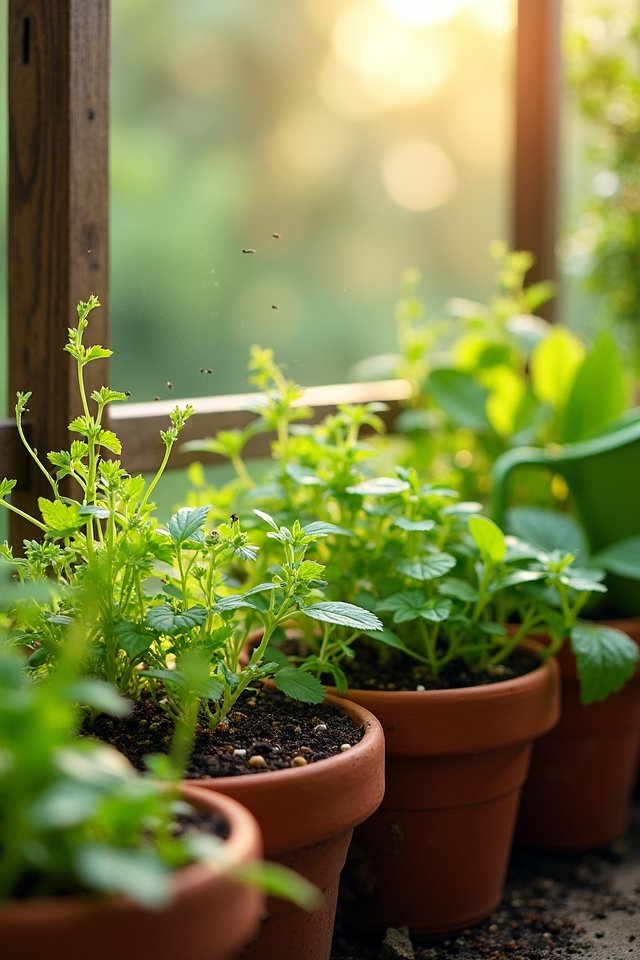
Healthy soil is like the secret sauce that makes your tiny garden thrive! To create this fertile wonderland, you’ll want to blend in some soil amendments—think compost, worm castings, or even a sprinkle of bone meal. These goodies boost nutrients, turning your earth into a feast for plants!
But there’s more! Microbial diversity plays a starring role. Imagine your soil as a bustling city, alive with microorganisms. Each tiny critter helps break down organic matter, releasing essential nutrients. You can kickstart this microbial fiesta by adding green manures or mulching with leaves. So, roll up your sleeves and dig deeply! Your tiny garden can flourish with rich, lively soil—like a town buzzing with happy neighbors! Isn’t that exciting?
Sustainable Watering Techniques for Tiny Spaces
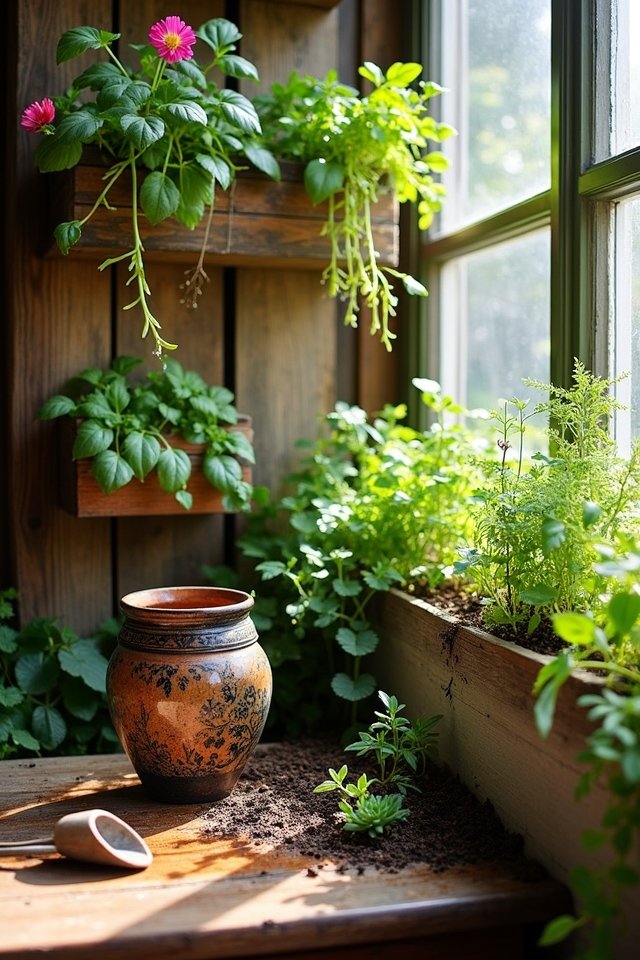
When you’re nurturing a tiny garden, keeping it hydrated can feel like a balancing act! You want your plants thriving, not gasping for water. That’s where drip irrigation swoops in like a superhero! This efficient system delivers moisture straight to your plant roots, saving water and time. Plus, it reduces the chance of pesky mildew—bonus!
Don’t forget about rainwater harvesting! Set up a stylish barrel to collect rainwater, and you’ll have a sustainable resource waiting for you. Just imagine the joy of watering your garden with precious drops captured fresh from the sky! So, adopt these innovative techniques. Your tiny garden will thank you, and you might become the neighborhood eco-hero! Gardening just got a whole lot smarter, right?
Organic Pest Control Methods for Urban Gardens
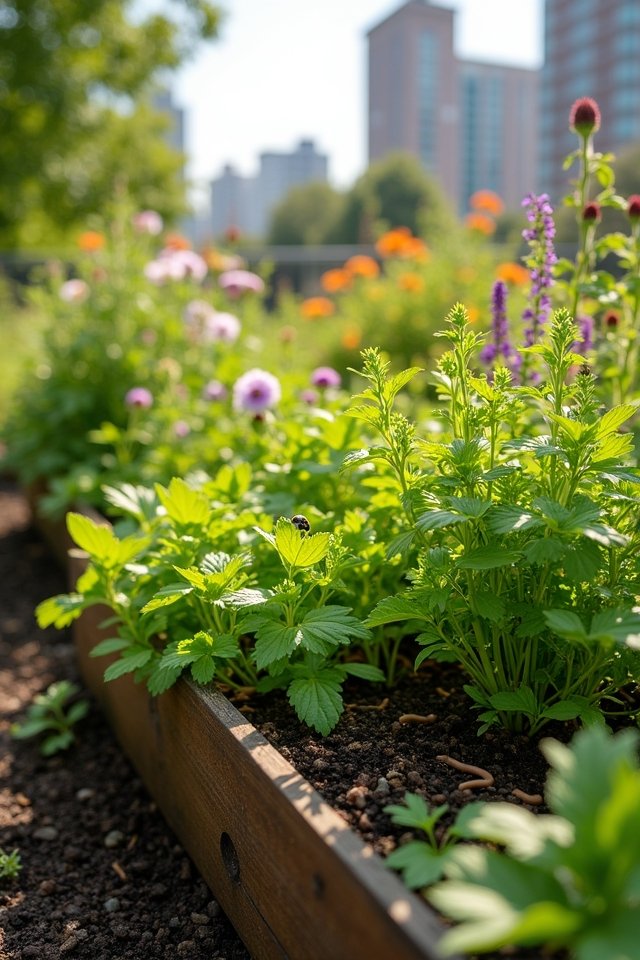
In the bustling world of urban gardening, you might feel like you’re in a constant battle against tiny intruders—those pesky pests trying to munch on your precious plants! But don’t worry, you can fight back with creative organic pest control methods. Start by inviting beneficial insects like ladybugs and lacewings; they’re the superheroes your garden needs! Create a simple spray with garlic and chili pepper—nature’s very own natural repellents. You’ll fend off unwelcome guests while creating a minor fiesta for your plants. Consider planting marigolds near your veggies; they act like a fragrant shield! These eco-friendly approaches not only protect your garden but also add a dash of ingenuity to your urban oasis. Happy gardening!
Seasonal Planting Strategies for Year-Round Harvest
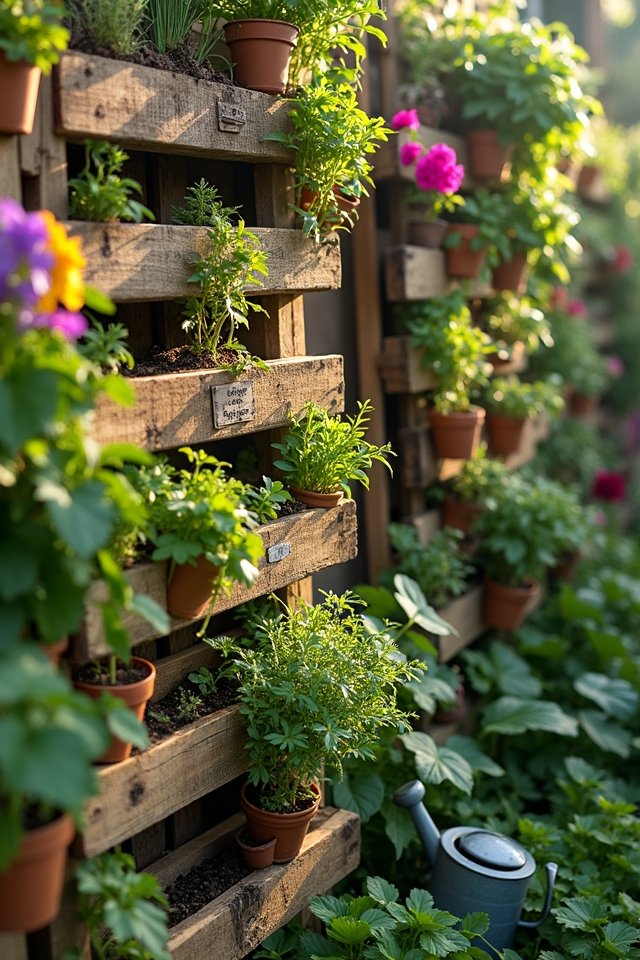
Ready to keep your garden thriving all year long? Welcome the seasons and discover the joy of planting! With strategic seasonal varieties, you can enjoy fresh produce every month. Here’s how to master seasonal planting:
- Rotate your crops: It’s not just smart; it’s delicious! Alternate your veggies to prevent pests and boost soil health.
- Choose quick-growing greens: Think arugula and spinach! These tasty leaves flourish in cooler months, offering crisp rewards.
- Plant perennials: Consider herbs like chives and thyme! They sprout back every year, giving your garden a reliable zing.
Creative Ideas for Composting in Small Areas
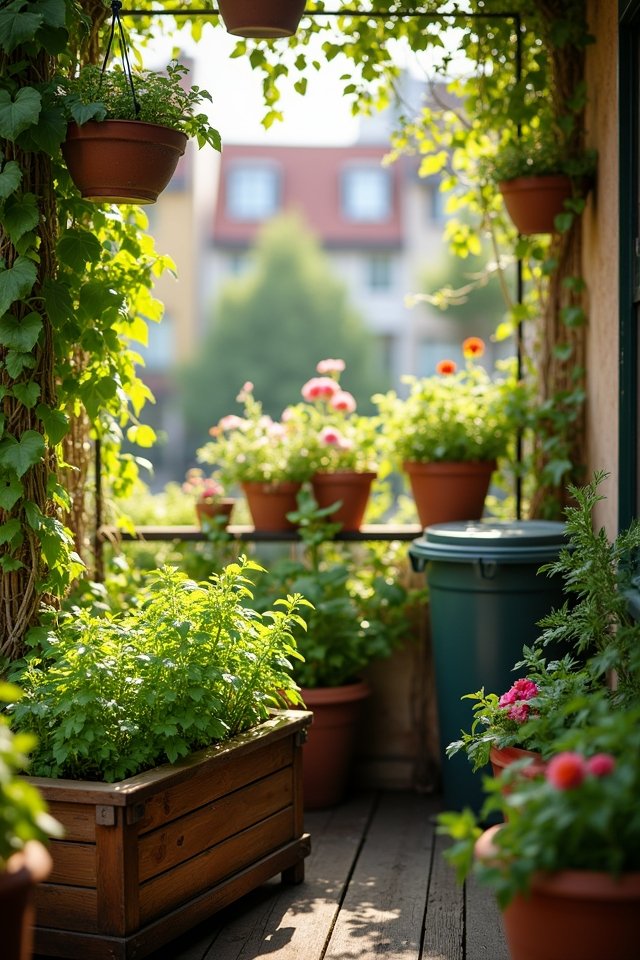
Expanding your garden’s potential doesn’t just stop at seasonal planting; there’s also an eco-friendly way to boost your soil’s health—composting! Living in a small space? No problem! Worm bins are your secret weapon. These nifty little guys break down kitchen scraps while taking up minimal room. Just imagine, you’re creating rich, dark compost while “petting” your wriggly friends! Indoor composting is another brilliant idea. You can use a sealed container on your kitchen counter. Toss in coffee grounds, vegetable peels, and egg shells. Before you know it, you’ll have a nutrient powerhouse for your plants! So, why not transform waste into garden gold? Get creative, and adopt composting—your tiny space can be a bountiful oasis!
Frequently Asked Questions
What Are the Benefits of Organic Gardening in Tiny Spaces?
Did you know that urban gardens can reduce air pollution by up to 30%? That’s impressive! When you adopt organic gardening in tiny spaces, you not only grow fresh, delicious veggies but also help your community thrive. Your little patch of greenery promotes sustainability practices and brings neighbors together. Imagine the pride of harvesting your tomatoes while knowing you’re doing your part for the planet. It’s not just gardening; it’s a revolution in your backyard!
How Can I Start a Tiny Garden on a Budget?
Starting a tiny garden on a budget is easier than you think! Grab some containers from your kitchen or local thrift store and get ready to grow! Choose budget-friendly plants like herbs, radishes, or lettuce—they’re like the superheroes of container gardening! You’ll have fresh basil for your pasta and crispy lettuce for salads in no time. Just imagine plucking your own veggies; it’ll make your heart sing! So, let’s dig in and have some fun!
What Common Pests Affect Small Urban Gardens?
Imagine your tiny garden as a bustling café—wait, what’s that? Aphids sipping on sap! Common pests like these, spider mites, and whiteflies can crash your urban gardening party. For pest management, integrate ladybugs and neem oil—it’s like serving the bad guys their eviction notice. Keep a close eye and react swiftly, ’cause your plants deserve a cozy, pest-free haven! So, roll up your sleeves and protect your leafy friends with a smile!
How Often Should I Fertilize My Tiny Garden?
Fertilizing your tiny garden is key to its success! You should mix it up with different fertilizer types like organic compost or liquid feed. Ideally, apply fertilizer every 4-6 weeks during the growing season. Think of it like a power-up for your plants—just the boost they need! Don’t forget to check the labels for specific application timings. Your plants will flourish, and you’ll feel like a garden wizard! Keep that green thumb happy!
Can I Grow Flowers Along With My Vegetables?
Why not add some blooms to your veggie patch? You can definitely grow flowers alongside your vegetables! Companion planting boosts your garden’s health; marigolds can deter pests while attracting pollinators. Think of vibrant zinnias dancing next to your tomatoes, creating a visual feast! Just choose your flower selection wisely—some may compete for nutrients. Welcome the colorful chaos and transform your little garden into a thriving tapestry of beauty and bounty! What’s not to love?
